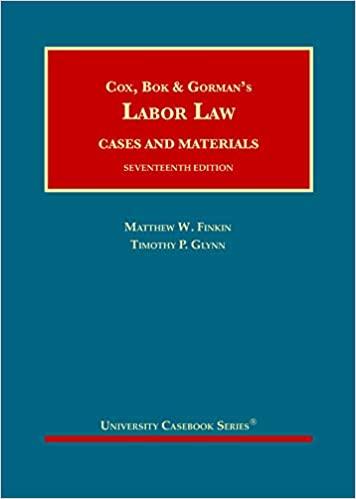Please respond to questions 1 and 2 on image 2.
Case 2.2 Animal Legal Defense Fund v. Wasden United States Court of Appeals, Ninth Circuit, 878 F.3d 1184 (2018). Background and Facts An animal rights activist who worked at an Idaho dairy farm secretly filmed ongoing animal abuse. After being posted online, the film attracted national attention. The dairy owner fired the abusive employees, established a code of conduct, and undertook an animal welfare audit of the farm. Meanwhile, the Idaho state legislature enacted the Interference with Agricultural Production statute, which was targeted at undercover investigation of agricultural operations. The statute's "Recordings Clause" criminalized making audio and video recordings of an agricultural production facility without the owner's consent. The Animal Legal Defense Fund filed a suit in a federal district court against Lawrence Wasden, the Idaho attorney general, alleging that the statute's Recordings Clause violated the First Amendment of the U.S. Constitution. The court issued an injunction against its enforcement. The state appealed this order to the U.S. Court of Appeals for the Ninth Circuit. In the Language of the Court MCKEOWN, Circuit Judge: * * * The Recordings Clause regulates speech protected by the First Amendment and is a classic example of a content-based restriction that cannot survive strict scrutiny. We easily dispose of Idaho's claim that the act of creating an audiovisual recording is not speech protected by the First Amendment. This argument is akin to saying that even though a book is protected by the First Amendment, the process of writing the book is not. Audiovisual recordings are protected by the Case 2.2 ContinuesContinued First Amendment as recognized organs of public opinion and as a significant medium for the communication of ideas. [Emphasis added.] * * * * The Recordings Clause prohibits the recording of a defined topic-"the conduct of an agricultural production facility's operations." * * * A regulation is content-based when it draws a distinction on its face regarding the message the speaker conveys or when the purpose and justification for the law are con- tent based. The Recordings Clause checks both boxes. * * * A videographer could record an after-hours birthday party among co-workers, a farmer's antique car collection, or a historic maple tree but not the animal abuse, feedlot operation, or slaughterhouse conditions. * * * * As a content-based regulation, the Recordings Clause is constitutional only if it * * * is necessary to serve a compelling state interest and is narrowly drawn to achieve that end. * * * Idaho asserts that the Recordings Clause protects both property and privacy interests. Even assuming a compelling government interest, Idaho has not satisfied the narrow tailoring requirement because the statute is both under-inclusive and over-inclusive. [Emphasis added. ] [For example,] prohibiting only "audio or video recordings," but saying nothing about photographs, is suspiciously under-inclusive. Why the making of audio and video recordings of operations would implicate property or privacy harms, but photographs of the same content would not, is a mystery. * * * * The Recordings Clause is also over-inclusive and suppresses more speech than necessary to further Idaho's stated goals of protecting property and privacy. Because there are various other laws at Idaho's disposal that would allow it to achieve its stated interests while burdening little or no speech, the law is not narrowly tailored. For example, agricultural production facility owners can vindicate their rights through tort laws against theft of trade secrets, * * * invasion of privacy, [and] defamation. Decision and Remedy The U.S. Court of Appeals for the Ninth Circuit affirmed the lower court's order preventing the enforcement of the statute. A law that concerns rights under the First Amendment must be narrowly tailored to accomplish its objective. The federal appellate court concluded that Idaho's Recordings Clause could not "survive First Amendment scrutiny" and was unconstitutional. Critical Thinking . Legal Environment How does the making of "audio and video recordings of an agricultural production facility" fall under the protection of the First Amendment? . What If the Facts Were Different? Suppose that instead of banning recordings of an agricultural production facility's operations, the state had criminalized misrepresentations by journalists to gain access to such a facility. Would the result have been different? Explain








